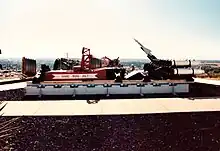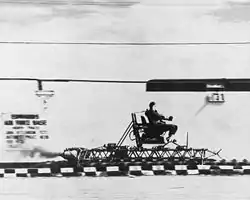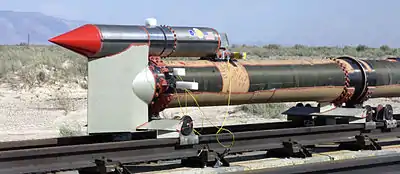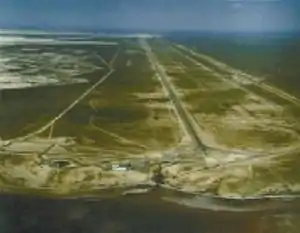Rocket sled
A rocket sled is a test platform that slides along a set of rails, propelled by rockets.


As its name implies, a rocket sled does not use wheels and differs from a rocket car for this reason as it runs on rails. Instead, it has sliding pads, called "slippers", which are curved around the head of the rails to prevent the sled from flying off the track.[1] The rail cross-section profile is that of a Vignoles rail, commonly used for railroads. Wheels cannot be used on rocket sleds as the high velocities experienced will result in the wheels spinning to pieces due to extreme centrifugal forces.
A rocket sled holds the land-based speed record for a vehicle, at Mach 8.5.
Usage


A rocket sled is reported to have been used in the closing days of World War II by the Germans to launch a winged A4b strategic rocket from a tunnel on March 16, 1945.
Rocket sleds were used extensively early in the Cold War to accelerate equipment considered too experimental (hazardous) for testing directly in piloted aircraft. The equipment to be tested under high acceleration or high airspeed conditions was installed along with appropriate instrumentation, data recording and telemetry equipment on the sled. The sled was then accelerated according to the experiment's design requirements for data collection along a length of isolated, precisely level and straight test track. Testing ejection seat systems and technology prior to their use in experimental or operational aircraft was a common application of the rocket sled at Holloman Air Force Base. Perhaps the most famous, the tracks at Edwards Air Force Base were used to test missiles, supersonic ejection seats, aircraft shapes and the effects of acceleration and deceleration on humans. The rocket sled track at Edwards Air Force Base was dismantled and used to extend the track at Holloman Air Force Base, taking it to almost 10 miles (16 km) in length.
Unmanned rocket sleds continue to be used to test missile components without requiring costly live missile launches. A world speed record of Mach 8.5 (6,416 mph / 10,325 km/h) was achieved by a four-stage rocket sled at Holloman Air Force Base on April 30, 2003, the highest speed ever attained by a land vehicle.[2]
Murphy's law first received public attention during a press conference about rocket sled testing.[3]
Examples
| Name | Location | Country | Length | Gauge | Rail Type | Welded/ Segmented |
Opened | Renovated | Closed | Geography/Notes |
|---|---|---|---|---|---|---|---|---|---|---|
| Holloman High Speed Test Track (HHSTT) Rails 1&2 | Holloman AFB, Alamogordo, NM | USA | 50,971 ft (15.536 km) |
84 in (2.1 m) |
171 | Welded | 1950 | 1956, 1957, 1974, 2000, 2002 | Runs North-South, 32.8881°N 106.1502°W | |
| Supersonic Naval Ordnance Research Track (SNORT) | NAWC-WD Naval Air Weapons Station, China Lake, CA | USA | 21,550 ft (6.568 km) |
56.5 in (1.435 m) |
171 | Welded | 1953 | 2006 | North-South | |
| Holloman High Speed Test Track (HHSTT) Rail 3 | Holloman AFB, Alamogordo, NM | USA | 20,200 ft (6.157 km) |
26.3 in (0.67 m) |
171 | Welded | 1974 | North-South | ||
| Extended High-Speed Rocket Sled Track | Edwards AFB, Edwards, CA | USA | 20,000 ft (6.096 km) |
56.5 in (1.435 m) |
171 | Welded | 1949 | 1959 | 1963 | Also known as South Base Sled Track (SBST). Rails used to lengthen HHSTT |
| Rail Track Rocket Sled Test Facility[4][5] | Terminal Ballistics Research Laboratory Range, Ramgarh, Haryana | India | 3.8 km (12,467 ft) |
0.7–4.86 m (28–191 in) |
1988 | 2014 | 5 rails North/South | |||
| Supersonic Military Air Research Track (SMART) | Aircraft Interior Products Propulsion Systems, Hurricane Mesa, UT | USA | 12,000 ft (3.658 km) |
56.5 in (1.435 m) |
105 | Welded | 1955 | 1961* | *Now Privately Owned & Operational | |
| Sandia 2 | Technical Area III, Kirtland AFB, Albuquerque, NM | USA | 10,000 ft (3.048 km) |
0.56 m (22 in) |
1966 | 1985 | North-South | |||
| Rocket rail track 3500, FKP GkNIPAS | Beloozyorsky | Russia | 3.5 km (11,480 ft) |
Segmented | 2014 | 55.48677°N 38.49836°E Formerly RD-2500. Used by Zvezda for ejection seat testing | ||||
| RT-2650, FKP NII Geodeziya | Krasnoarmeysk | Russia | 2,650 m (8,694 ft) |
R-75 | 1956 | 1984 | 56.11901°N 38.20345°E | |||
| TsKP MIK of RFNC-VNIIEF | Sarov | Russia | 3.0 km (9,843 ft) |
54.8212°N 43.2530°E | ||||||
| B-4 Transonic Test Track | NAWC-WD Naval Air Weapons Station, China Lake, CA | USA | 6,800 ft (2,073 m) |
56.5 in (1.435 m) |
75 | Welded | 1940 | |||
| Martin-Baker Langford Lodge | Langford Lodge, Northern Ireland | UK | 6,200 ft (1,890 m) |
30 in (0.762 m) |
80 | 1971 | Privately Owned & Operated by Martin-Baker | |||
| Pendine Long Test Track (LTT) | QinetiQ, Pendine, Wales | UK | 1,500 m (4,921 ft) |
12 in (0.305 m) |
103 | 1956 | ||||
| Centre D'essais Des Landes Single Rail R1 | Biscarrosse, France | France | 2.0 km (6,562 ft) |
Monorail | Square Beam | Segmented | 1968 | (Foundation for 2nd rail in place) | ||
| G-4 Exterior and Terminal Ballistics Test Track | NAWC-WD Naval Air Weapons Station, China Lake, CA | USA | 3,000 ft (914 m) |
33.875 in (0.860 m) |
171 | Welded | 1954 | |||
| ETTC KEMTF sled track | Test Area C-74, Eglin AFB, Ft. Walton Beach, FL | USA | 2,000 ft (610 m) |
56.5 in (1.435 m) |
171 | Welded | 1956 | |||
| Sandia 1 | Technical Area III, Kirtland AFB, Albuquerque, NM | USA | 2,000 ft (610 m) |
56.5 in (1.435 m) |
1951 | |||||
| Edwards North Base Track "G-Whiz" | Edwards AFB, Edwards, CA | USA | 2,000 ft (610 m) |
Welded | 1944 | 1953 | Also known as North Base Sled Track (NBST). | |||
| Redstone Technical Test Center Sled Track 1 | Redstone Arsenal, AL | USA | 1,900 ft (579 m) |
Monorail | 1956 | |||||
| Pendine Impact Test Track | QinetiQ, Pendine, Wales | UK | 400 m (1,312 ft) |
56.5 in (1.435 m) |
||||||
| Centre D'essais Des Landes Single Rail R2 | Biscarrosse, France | France | 400 m (1,312 ft) |
Square Beam | 1967 | Former HB3 track, moved from CIEES Colomb-Béchar, Algeria | ||||
| Redstone Technical Test Center Sled Track 2 | Redstone Arsenal, AL | USA | 1,200 ft (366 m) |
Monorail | ||||||
| New Mexico Tech/EMRTC Sled Track | Socorro, NM | USA | 1,000 ft (305 m) |
Monorail | 171 | Privately owned & operated | ||||
| Pendine Short Test Track (STT) | QinetiQ, Pendine, Wales | UK | 200 m (656 ft) |
|||||||
| General Dynamics Ordnance and Tactical Systems | Rock Hill, FL | USA | 656 ft (200 m) |
I-Beam | Privately Owned & Operated | |||||
| Alkantpan Rocket Sled Range | Alkantpan Test Range, Copperton, Northern Cape | South Africa | 200 m (656 ft) |
0.5 m (19.7 in) |
Single or Double I-beam | Segmented | 1985 | 1999 | Runs East to West, 29.947448°S 22.226614°E
Subsonic and supersonic testing | |
| Holloman Maglev Track | Holloman AFB, Alamogordo, NM | USA | 2,100 ft (640 m) |
|||||||
| Germany | Germany | I-Beam | ||||||||
| Bundeswehr WTD 91 rocket sled track | Meppen | Germany | 830 m (2,723 ft) |
52.8631°N 7.4084°E | ||||||
| AVIC ALI track | Xiangyang | China | 6.0 km (19,685 ft) |
1993 | 2006 | 32.3939°N 112.1386°E | ||||
| Muroran Institute of Technology APReC HSTT | Shiraoi | Japan | 300 m (984 ft) |
1.435 m (56.5 in) |
2009 | 42.5358°N 141.2558°E | ||||
| Muroran Institute of Technology APReC SSTT | Shiraoi | Japan | 100 m (328 ft) |
0.128 m (5.04 in) |
2008 | 42.5357°N 141.2552°E | ||||
| TÜBİTAK SAGE HABRAS | Karapınar | Turkey | 2.0 km (6,562 ft) |
2017 | 37.6212°N 33.4634°E |
Other former rocket sled tracks include those at the following locations:
- Peenemünde, Germany (V-1 launch ramp)
- Colomb-Béchar, Algeria (HB3 rail of CIEES)
- PISQ, Salto di Quirra, Sardinia, Italy
- Satory, France
- Istres-Le Tubé Air Base, France (used by René Leduc for the SE 1910)
- Cazaux Air Base, France
- Aberdeen Proving Ground, Maryland, USA
- Institute of Aviation Medicine, Farnborough, UK
See also
References
- "The Fastest Rocket Sled On Earth". impactlab.com. 16 January 2006. Retrieved 2008-03-18.
- "Test sets world land speed record". www.af.mil. Retrieved 2016-04-19.
- "Murphy's laws origin". murphys-laws.com. Archived from the original on 2012-03-10. Retrieved 2008-03-18.
- "SA To RM Inaugurates Unique "RTRS Penta Rail Supersonic Track" at TBRL" (PDF). Defence Research & Development Organisation (DRDO). 12 May 2014. Archived from the original (PDF) on 9 May 2019. Retrieved 9 May 2019.
- "Technology Focus magazine Vol. 25 No. 3, May-June 2017" (PDF). 9 June 2017. Archived from the original (PDF) on 9 May 2019. Retrieved 9 May 2019.